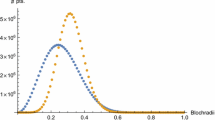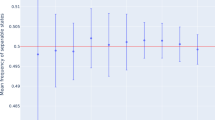Abstract
Using a geometric measure of entanglement quantification based on Euclidean distance of the Hermitian matrices (Patel and Panigrahi in Geometric measure of entanglement based on local measurement, 2016. arXiv:1608.06145), we obtain the minimum distance between the set of bipartite n-qudit density matrices with a positive partial transpose and the maximally mixed state. This minimum distance is obtained as \(\frac{1}{\sqrt{d^n(d^n-1)}}\), which is also the minimum distance within which all quantum states are separable. An idea of the interior of the set of all positive semidefinite matrices has also been provided. A particular class of Werner states has been identified for which the PPT criterion is necessary and sufficient for separability in dimensions greater than six.







Similar content being viewed by others
References
Bruß, D.: Characterizing entanglement. J. Math. Phys. 43, 4237–4251 (2002)
Xu, J.-S., Li, C.-F., Xu, X.-Y., Shi, C., Zou, X.-B., Guo, G.-C.: Experimental characterization of entanglement dynamics in noisy channels. Phys. Rev. Lett. 103, 240502 (2009)
Jaeger, G.: Entanglement, Information, and the Interpretation of Quantum Mechanics. Springer, Berlin (2009)
Bennett, C.H., Bernstein, H.J., Popescu, S., Schumacher, B.: Concentrating partial entanglement by local operations. Phys. Rev. A 53, 046–2052 (1996)
Bennett, C.H., Brassard, G., Popescu, S., Schumacher, B., Smolin, J.A., Wootters, W.K.: Purification of noisy entanglement and faithful teleportation via noisy channels. Phys. Rev. Lett. 76, 722–725 (1996)
Fortes, R., Rigolin, G.: Probabilistic quantum teleportation via thermal entanglement. Phys. Rev. A 96, 022315 (2017)
Imai, H., Hanaoka, G., Maurer, U., Zheng, Y., Naor, M., Segev, G., Smith, A., Safavi-Naini, R., Wild, P.R., Channels, Broadcast, et al.: Special issue on information theoretic security. IEEE Trans. Inf. Theory 52, 4348 (2006)
Alonso, J.G., Brun, T.A.: Error correction with orbital angular momentum of multiple photons propagating in a turbulent atmosphere. Phys. Rev. A 95, 032320 (2017)
Boileau, J.-C., Tamaki, K., Batuwantudawe, J., Laflamme, R., Renes, J.M.: Unconditional security of a three state quantum key distribution protocol. Phys. Rev. Lett. 94, 040503 (2005)
Wang, J., Li, L., Peng, H., Yang, Y.: Quantum-secret-sharing scheme based on local distinguishability of orthogonal multiqudit entangled states. Phys. Rev. A 95, 022320 (2017)
Gao, G., Wang, Y.: Comment on “proactive quantum secret sharing”. Quantum Inf. Process. 16, 74 (2017)
Moroder, T., Gittsovich, O., Huber, M., Gühne, O.: Steering bound entangled states: a counterexample to the stronger peres conjecture. Phys. Rev. Lett. 113, 050404 (2014)
DiVincenzo, D.P., Shor, P.W., Smolin, J.A., Terhal, B.M., Thapliyal, A.V.: Evidence for bound entangled states with negative partial transpose. Phys. Rev. A 61, 062312 (2000)
Braunstein, S.L., Caves, C.M.: Geometry of quantum states. In: Belavkin, V.P., Hirota, O., Hudson, R.L. (eds.) Quantum Communications and Measurement, pp. 21–30. Springer, Berlin (1995)
Zyczkowski, K., Sommers, H.-J.: Induced measures in the space of mixed quantum states. J. Phys. A Math. Gen. 34, 7111 (2001)
Zyczkowski, K., Slomczynski, W.: The monge metric on the sphere and geometry of quantum states. J. Phys. A Math. Gen. 34, 6689 (2001)
Patel, A.A., Panigrahi, P.K.: Geometric measure of entanglement based on local measurement (2016). arXiv preprint arXiv:1608.06145
Boyer, M., Liss, R., Mor, T.: Geometry of entanglement in the bloch sphere. Phys. Rev. A 95, 032308 (2017)
Ozawa, M.: Entanglement measures and the Hilbert–Schmidt distance. Phys. Lett. A 268, 58–160 (2000)
Heydari, H., Björk, G.: Entanglement measure for general pure multipartite quantum states. J. Phys. A Math. Gen. 37, 9251 (2004)
Peres, A.: Separability criterion for density matrices. Phys. Rev. Lett. 77, 1413–1415 (1996)
Goswami, A.K., Panigrahi, P.K.: Uncertainty relation and inseparability criterion. Found. Phys. 47, 229–235 (2017)
La Guardia, G.G., Pereira, F.F.: Good and asymptotically good quantum codes derived from algebraic geometry. Quantum Inf. Process. 16, 165 (2017)
Holik, F., Sergioli, G., Freytes, H., Giuntini, R., Plastino, A.: Toffoli gate and quantum correlations: a geometrical approach. Quantum Inf. Process. 16(2), 55 (2017)
Bhaskara, V.S., Panigrahi, P.K.: Generalized concurrence measure for faithful quantification of multiparticle pure state entanglement using Lagrange’s identity and wedge product. Quantum Inf. Process. 16, 118 (2017)
Zhou, Lan, Sheng, Yu-Bo: Concurrence measurement for the two-qubit optical and atomic states. Entropy 17(6), 4293–4322 (2015)
Banerjee, S., Panigrahi, P.K.: Parallelism of Vectors and Tangle as an Inequality in Area (2019). https://doi.org/10.13140/RG.2.2.31620.48002
Zhu, X.-N., Fei, S.-M.: Entanglement monogamy relations of qubit systems. Phys. Rev. A 90, 024304 (2014)
Zhou, L., Sheng, Y.-B.: Detection of nonlocal atomic entanglement assisted by single photons. Phys. Rev. A 90, 024301 (2014)
Zhang, M., Zhou, L., Zhong, W., Sheng, Y.-B.: Direct measurement of the concurrence of hybrid entangled state based on parity check measurements. Chin. Phys. B 28, 010301 (2019)
Sheng, Y.-B., Guo, R., Pan, J., Zhou, L., Wang, X.-F.: Two-step measurement of the concurrence for hyperentangled state. Quantum Inf. Process. 14(3), 963–978 (2015)
Gurvits, L., Barnum, H.: Largest separable balls around the maximally mixed bipartite quantum state. Phys. Rev. A 66, 062311 (2002)
Đoković, D.Ž.: On two-distillable Werner states. Entropy 18, 216 (2016)
Bandyopadhyay, S., Roychowdhury, V.: Maximally disordered distillable quantum states. Phys. Rev. A 69, 040302 (2004)
Lewenstein, M., Sanpera, A.: Separability and entanglement of composite quantum systems. Phys. Rev. Lett. 80, 2261–2264 (1998)
Lasserre, J.B.: A trace inequality for matrix product. Trans. IEEE Autom. Control 40, 1500–1501 (1995)
Życzkowski, K., Horodecki, P., Sanpera, A., Lewenstein, M.: Volume of the set of separable states. Phys. Rev. A 58, 883–892 (1998)
Rana, S.: Negative eigenvalues of partial transposition of arbitrary bipartite states. Phys. Rev. A 87, 054301 (2013)
Acknowledgements
The authors want to acknowledge valuable inputs from Prof. Somshubhro Bandyopadhyay (Bose Institute, Kolkata).
Author information
Authors and Affiliations
Corresponding author
Additional information
Publisher's Note
Springer Nature remains neutral with regard to jurisdictional claims in published maps and institutional affiliations.
Appendix A
Appendix A
1.1 Calculation for 3-qubit Werner state to be PPT
The 3-qubit Werner state with \(1 \otimes 2\) bi-partition is given by
where \(N=2^n\), \(p \in [0, 1]\); \(P_\psi \) is 3-qubit GHZ state and \(\frac{\mathbb {I}}{8}\) is the normalized identity matrix of order 8. Hence,
Carrying out the partial transposition operation, we have
Eigenvalues of \( \rho _{w_{3}}^{\mathrm{T}_B}\) are found to be,
Hence, the maximum value of p such that the partially transposed Werner state is positive semidefinite is \(\frac{1}{5}\).
Rights and permissions
About this article
Cite this article
Banerjee, S., Patel, A.A. & Panigrahi, P.K. Minimum distance of the boundary of the set of PPT states from the maximally mixed state using the geometry of the positive semidefinite cone. Quantum Inf Process 18, 296 (2019). https://doi.org/10.1007/s11128-019-2411-6
Received:
Accepted:
Published:
DOI: https://doi.org/10.1007/s11128-019-2411-6




